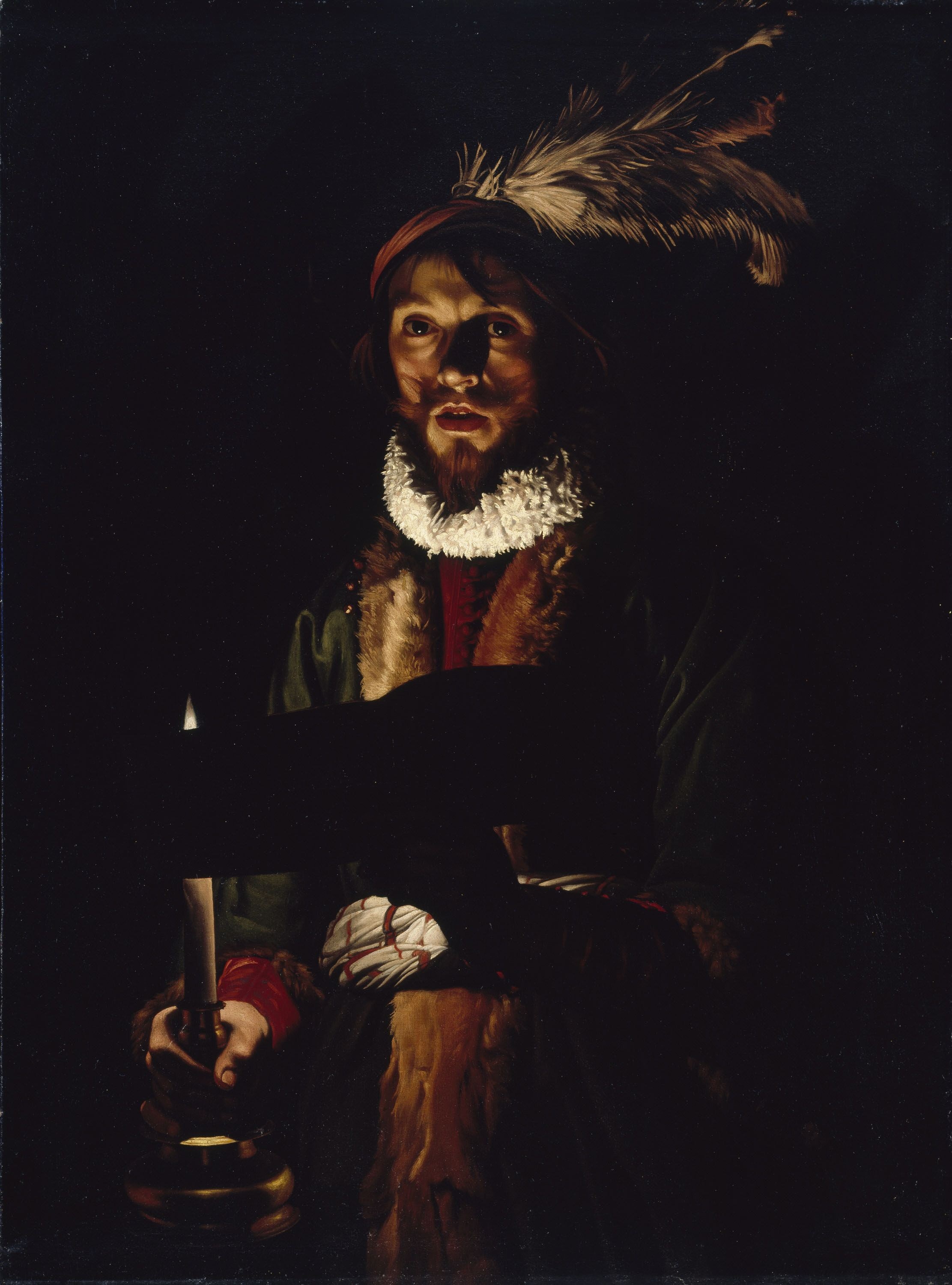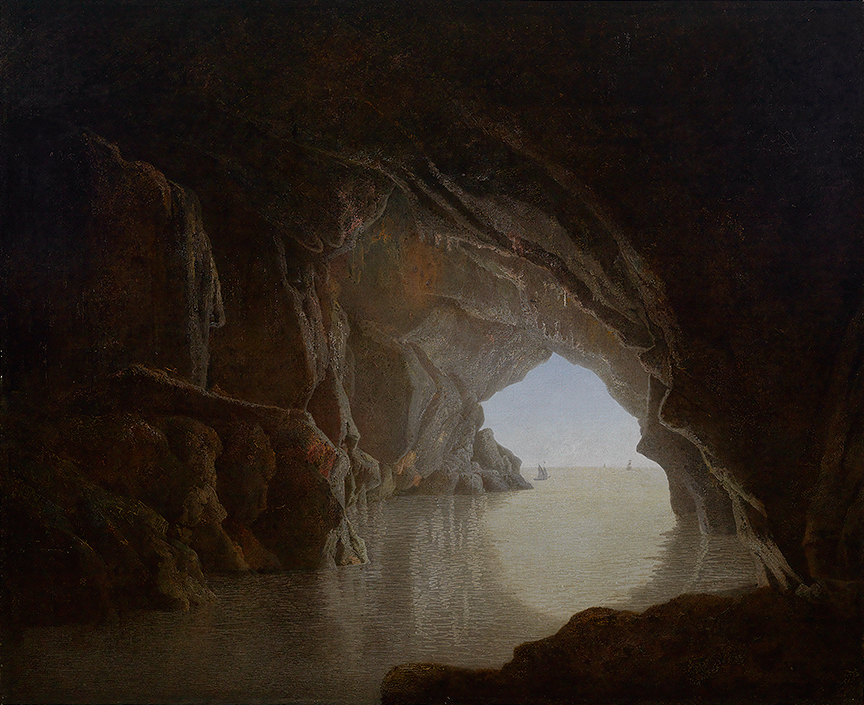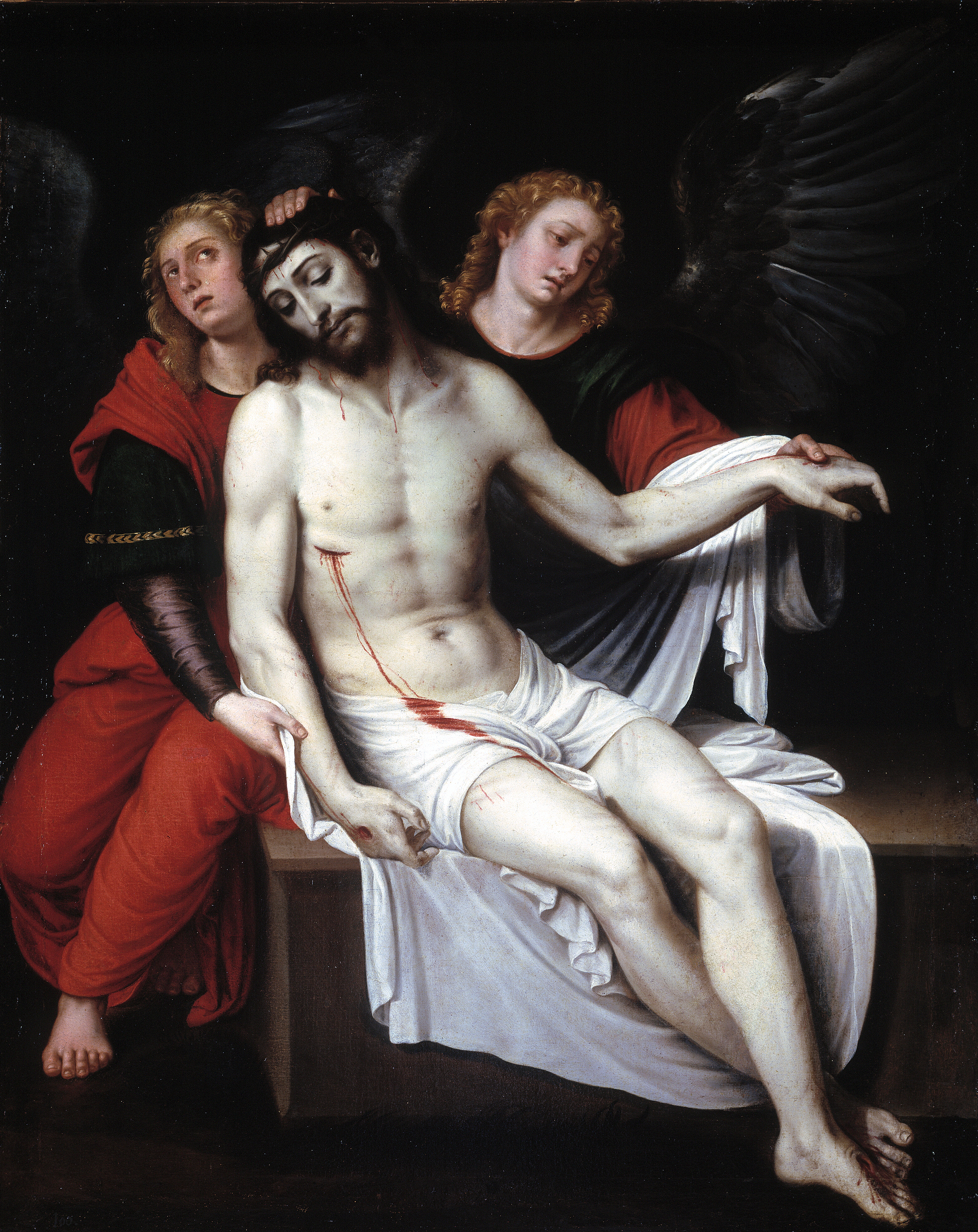|
Tenebrism
Tenebrism, from Italian ('dark, gloomy, mysterious'), also occasionally called dramatic illumination, is a style of painting using especially pronounced chiaroscuro, where there are violent contrasts of light and dark, and where darkness becomes a dominating feature of the image. The technique was developed to add drama to an image through a spotlight effect, and is common in Baroque paintings. Tenebrism is used only to obtain a dramatic impact while chiaroscuro is a broader term, also covering the use of less extreme contrasts of light to enhance the illusion of three-dimensionality. Baroque The artist Caravaggio is generally credited with the invention of the style, although this technique was also used by earlier artists such as Albrecht Dürer in his several self portraits; by Tintoretto in his dramatic religious paintings, such as The Miracle of St Mark; by El Greco, who painted three versions of a composition with a boy, a man, and a monkey grouped in darkness around ... [...More Info...] [...Related Items...] OR: [Wikipedia] [Google] [Baidu] |
Chiaroscuro
In art, chiaroscuro ( , ; ) is the use of strong contrasts between light and dark, usually bold contrasts affecting a whole composition. It is also a technical term used by artists and art historians for the use of contrasts of light to achieve a sense of volume in modelling three-dimensional objects and figures. Similar effects in cinema, and black and white and low-key photography, are also called chiaroscuro. Taken to its extreme, the use of shadow and contrast to focus strongly on the subject of a painting is called tenebrism. Further specialized uses of the term include chiaroscuro woodcut for colour woodcuts printed with different blocks, each using a different coloured ink; and chiaroscuro for drawings on coloured paper in a dark medium with white highlighting. Chiaroscuro originated in the Renaissance period but is most notably associated with Baroque art. Chiaroscuro is one of the canonical painting modes of the Renaissance (alongside cangiante, sfumato and uni ... [...More Info...] [...Related Items...] OR: [Wikipedia] [Google] [Baidu] |
Caravaggio
Michelangelo Merisi da Caravaggio (also Michele Angelo Merigi or Amerighi da Caravaggio; 29 September 1571 – 18 July 1610), known mononymously as Caravaggio, was an Italian painter active in Rome for most of his artistic life. During the final four years of his life, he moved between Kingdom of Naples, Naples, Hospitaller Malta, Malta, and Kingdom of Sicily, Sicily. His paintings have been characterized by art critics as combining a realistic observation of the human state, both physical and emotional, with a dramatic use of lighting, which had a formative influence on Baroque painting. Caravaggio employed close physical observation with a dramatic use of chiaroscuro that came to be known as tenebrism. He made the technique a dominant stylistic element, transfixing subjects in bright shafts of light and darkening shadows. Caravaggio vividly expressed crucial moments and scenes, often featuring violent struggles, torture, and death. He worked rapidly with live models, preferrin ... [...More Info...] [...Related Items...] OR: [Wikipedia] [Google] [Baidu] |
Joseph Wright Of Derby
Joseph Wright (3 September 1734 – 29 August 1797), styled Joseph Wright of Derby, was an English landscape and portrait painter. He has been acclaimed as "the first professional painter to express the spirit of the Industrial Revolution". Wright is notable for his use of tenebrism, an exaggerated form of the better known chiaroscuro effect, which emphasizes the contrast of light and dark, and for his paintings of candle-lit subjects. His paintings of the birth of science out of alchemy, often based on the meetings of the Lunar Society of Birmingham, a group of scientists and industrialists living in the English Midlands, are a significant record of the struggle of science against religious values in the period known as the Age of Enlightenment. Many of Wright's paintings and drawings are owned by Derby City Council, and are on display at the Derby Museum and Art Gallery. Life Joseph Wright was born in Irongate, Derby, to a respectable family of lawyers. He was the third ... [...More Info...] [...Related Items...] OR: [Wikipedia] [Google] [Baidu] |
Jusepe De Ribera
Jusepe de Ribera (; baptised 17 February 1591 – 3 November 1652) was a Spanish painter and Printmaking, printmaker. Ribera, Francisco de Zurbarán, Bartolomé Esteban Murillo, and the singular Diego Velázquez, are regarded as the major artists of Spanish Baroque painting. Referring to a series of Ribera exhibitions held in the late 20th century, Philippe de Montebello wrote "If Ribera's status as the undisputed protagonist of Neapolitan painting had ever been in doubt, it was no longer. Indeed, to many it seemed that Ribera emerged from these exhibitions as not simply the greatest Naples, Neapolitan artist of his age but one of the outstanding European masters of the seventeenth century."Pérez-Sánchez, Alfonso E., and Nicola Spinosa. 1992. Jusepe de Ribera 1519–1652'. The Metropolitan Museum of Art/Harry N. Abrams, Inc. New York. 290 pp, Jusepe de Ribera has also been referred to as José de Ribera (usual in Spanish and French), Josep de Ribera (in Catalan), and was called ... [...More Info...] [...Related Items...] OR: [Wikipedia] [Google] [Baidu] |
Artemisia Gentileschi
Artemisia Lomi Gentileschi ( ; ; 8 July 1593) was an Italian Baroque painter. Gentileschi is considered among the most accomplished 17th century, 17th-century artists, initially working in the style of Caravaggio. She was producing professional work by the age of 15. In an era when women had few opportunities to pursue artistic training or work as professional artists, Gentileschi was the first woman to become a member of the Accademia delle Arti del Disegno, Accademia di Arte del Disegno in Florence and she had an international clientele. Many of Gentileschi's paintings feature women from myths, allegories, and the Bible, including victims, suicides, and warriors. Some of her best-known subjects are ''Susanna and the Elders'' (particularly Susanna and the Elders (Artemisia Gentileschi, Pommersfelden), 1610 version in Schloss Weißenstein, Pommersfelden), ''Judith Slaying Holofernes'' (her Judith Slaying Holofernes (Artemisia Gentileschi, Florence), 1614–1620 version is in the ... [...More Info...] [...Related Items...] OR: [Wikipedia] [Google] [Baidu] |
Francisco Ribalta
Francesc Ribalta (2 June 1565 – 12 January 1628), also known as ''Francisco Ribaltá'' or ''de Ribalta'', was a Spanish painter of the Baroque period, mostly of religious subjects. Biography He was born in Solsona, Lleida. Although his first apprenticeship was apparently with Navarrete, who worked for years in the Escorial, Ribalta's earliest work (a ''Cruxifixion'' of 1582) was signed in Madrid. After his years in Madrid, Ribalta was to settle as an artist in Valencia. He became among the first followers in Spain of the austere tenebrist style of Caravaggio. It is unclear if he directly visited either Rome or Naples, where Caravaggio's style had many adherents. Alternatively, it is likely that tenebrist paintings were available in Spain by the early 17th century through the Spanish rule of the Neapolitan kingdom. Jusepe de Ribera is said to have been one of his pupils, although it is entirely possible that Ribera acquired his tenebrism when he moved to Italy. Style ... [...More Info...] [...Related Items...] OR: [Wikipedia] [Google] [Baidu] |
Adam De Coster
Adam de Coster (c. 1586 in Mechelen – 4 May 1643 in Antwerp) was a Flemish painter. He was a prominent member of the Antwerp Caravaggisti. These Caravaggisti were part of an international movement of European artists who interpreted the work of Caravaggio and the followers of Caravaggio in a personal manner.Anna Orlando, ''Schede in Lights and Shadows. Caravaggism in Europe'' catalogo della mostra, Cesare Lampronti Gallery, London, 2015, pp. 76-77 He is mainly known for his with strong |
Effets De Soir
''Effets de soir'' (also called ''effets de soir et de matin'') are the effects of light caused by the sunset, twilight, or darkness of the early evening or matins. They appear frequently in works by such painters as Vincent van Gogh, Bernhard Fries,Cosmovisions website on B. Fries in French). Retrieved October 16, 2008. Armand Guillaumin, and .Cosmovisions website on Corot (in French). Retrieved October 16, 2008. [...More Info...] [...Related Items...] OR: [Wikipedia] [Google] [Baidu] |
Romanticism
Romanticism (also known as the Romantic movement or Romantic era) was an artistic and intellectual movement that originated in Europe towards the end of the 18th century. The purpose of the movement was to advocate for the importance of subjectivity and objectivity (philosophy), subjectivity, imagination, and appreciation of nature in society and culture in response to the Age of Enlightenment and the Industrial Revolution. Romanticists rejected the social conventions of the time in favour of a moral outlook known as individualism. They argued that passion (emotion), passion and intuition were crucial to understanding the world, and that beauty is more than merely an classicism, affair of form, but rather something that evokes a strong emotional response. With this philosophical foundation, the Romanticists elevated several key themes to which they were deeply committed: a Reverence (emotion), reverence for nature and the supernatural, nostalgia, an idealization of the past as ... [...More Info...] [...Related Items...] OR: [Wikipedia] [Google] [Baidu] |
Godfried Schalcken
Godfried Schalcken (8 October 1643 – 16 November 1706) was a Dutch artist who specialized in genre paintings and portraits. Schalcken was noted for his night scenes and mastery in reproducing the effect of candlelight. He painted in the highly polished style of the Leiden fijnschilders. Life and work Godfried Schalcken was born in Made, North Brabant, the son of Cornelis Schalcken and Aletta Lydius. Before he was four years old, his family moved to Dordrecht, where his father became rector of the Latin school. Schalcke studied under Samuel van Hoogstraten in Dordrecht before he moved to Leiden, into the studio of Gerard Dou (1613–1675), one of Rembrandt's most famous pupils. His earlier genre pictures very closely resemble Dou's work. He worked in Leiden until c. 1675, then returning to Dordrecht until 1691, after which he settled in The Hague, where he continued to paint until his death, near age 63, in 1706. He also visited England (1692–1697), but his uncouth manners ... [...More Info...] [...Related Items...] OR: [Wikipedia] [Google] [Baidu] |
Sotheby's
Sotheby's ( ) is a British-founded multinational corporation with headquarters in New York City. It is one of the world's largest brokers of fine art, fine and decorative art, jewellery, and collectibles. It has 80 locations in 40 countries, and maintains a significant presence in the UK. Sotheby's was established on 11 March 1744 in London by Samuel Baker, a bookseller. In 1767 the firm became Baker & Leigh, after George Leigh became a partner, and was renamed to Leigh and Sotheby in 1778 after Baker's death when his nephew, John Sotheby, inherited Leigh's share. Other former names include: Leigh, Sotheby and Wilkinson; Sotheby, Wilkinson and Hodge (1864–1924); Sotheby and Company (1924–83); Mssrs Sotheby; Sotheby & Wilkinson; Sotheby Mak van Waay; and Sotheby's & Co. The American holding company was initially incorporated in August 1983 in Michigan as Sotheby's Holdings, Inc. In June 2006, it was reincorporated in the State of Delaware and was renamed Sotheby's. In June ... [...More Info...] [...Related Items...] OR: [Wikipedia] [Google] [Baidu] |
Rembrandt
Rembrandt Harmenszoon van Rijn (; ; 15 July 1606 – 4 October 1669), mononymously known as Rembrandt was a Dutch Golden Age painter, printmaker, and Drawing, draughtsman. He is generally considered one of the greatest visual artists in the history of Art of Europe, Western art.Gombrich, p. 420. It is estimated that Rembrandt's surviving works amount to about three hundred paintings, three hundred etchings and several hundred drawings. Unlike most Dutch painters of the 17th century, Rembrandt's works depict a wide range of styles and subject matter, from portrait painting, portraits and self-portraits to landscapes, genre scenes, allegorical and historical scenes, biblical and mythological subjects and animal studies. His contributions to art came in a period that historians call the Dutch Golden Age. Rembrandt never went abroad but was considerably influenced by the work of the Italian Old Masters and Bentvueghels, Dutch and Flemish artists who had studied in Italy. A ... [...More Info...] [...Related Items...] OR: [Wikipedia] [Google] [Baidu] |











